Essential Plant Nutrients Explained,
What Plants Need and Why
Just as us humans get nutrients from the food we eat, think about it for a minute, are you getting enough protein? are you getting enough vitamins and other minerals? We need a balanced diet to ensure we stay healthy.
Plants also need nutrients to be at their best and grow properly, don’t forget plants are living things after all.
Can you guess what nutrients plants need to be able to grow properly? Can you tell if your plant is healthy and getting enough nutrients?
There are 17 essential plant nutrients that plants need of which 14 come from the soil. What are the 17 essential plant nutrients?
- 1: Nitrogen (N)
- 2: Phosphorus (P)
- 3: Potassium (K)
- 4: Calcium (Ca)
- 5: Magnesium (Mg)
- 6: Sulphur (S)
- 7: Chlorine (Cl)
- 8: Iron (Fe)
- 9: Manganese (Mn)
- 10: Zinc (Zn)
- 11: Copper (Cu)
- 12: Boron (B)
- 13: Molybdenum (Mo)
- 14: Nickel (Ni)
- 15: Oxygen (O) Found in Air and Water
- 16: Carbon (C) Found in Air
- 17: Hydrogen (H) Found in Water
The bulk of a plant is made up of oxygen, carbon and hydrogen, these are obtained from air and water and converted to a solid form during photosynthesis. The other 14 are from the soil.
Plant nutrients are classified into 3 sections – Primary Nutrients, Secondary Nutrients and Micronutrients
The difference between them is that a Plants need for Primary and Secondary Nutrients is much higher when compared with Micronutrients.
What amount of nutrients do plants need?
Well, the relative amounts out of 100 of these essential nutrients required by most plants are:
Primary Nutrients
- Carbon 45
- Oxygen 45
- Hydrogen 6
- Nitrogen 1.5
- Potassium 1
- Phosphorus 0.2
Secondary Nutrients
- Calcium 0.5
- Magnesium 0.2
- Sulphur 0.1
Micronutrients
- Iron 0.01
- Chlorine 0.01
- Manganese 0.005
- Boron 0.002
- Zinc 0.002
- Copper 0.0006
- Molybdenum 0.00001
- Nickel Unknown
Without these nutrients plants will suffer from nutrient deficiencies which will affect how they grow and how much fruit they produce.
Primary Nutrients
Nitrogen (N)
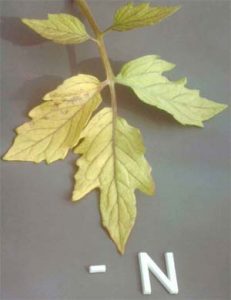
Nitrogen deficiency in plants. Source
Essential for the formation of amino acids and proteins, it’s the building block of plant proteins, it is essential for plant growth and in promoting healthy foliage.
What are the signs of nitrogen deficiency?
Nitrogen deficiency leads to reduced growth, one of the main signs of nitrogen deficiency is the foliage turning a light green to yellow colour, symptoms usually appear first on older growth.
Just as you can have nitrogen deficiency you can also have excess nitrogen so be careful. Excess nitrogen can cause poor fruit set, brittle leaves and may also lead to excess ammonia which can induce calcium deficiency.
Phosphorus (P)
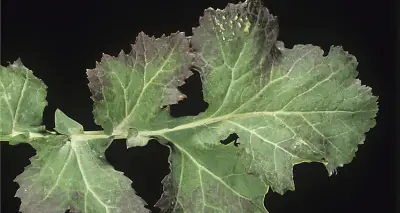
Phosphorus deficency in plants. Source
Phosphorus is needed for the development and growth of plants, also helps to develop a strong root system for plants. Phosphorus also affects the quality of seed, fruit and flower production of plants. So, if you feed plants with phosphorus, they will produce more flowering blooms and tastier fruit and vegetables.
Phosphorus also helps to increases a plant’s resistance to disease.
Phosphorus deficiency leads to the reduced growth of a plant, plants may have limited root growth, distorted foliage and purple red colour in the leaves specially on the underside of the leaf along the veins.
Potassium (K)
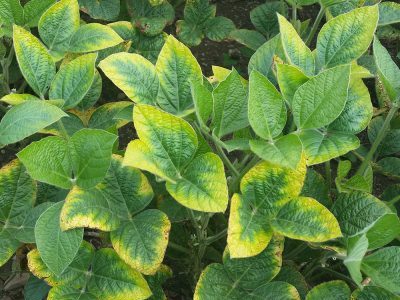
Potassium deficiency in plants. Source
Potassium is kind of all-rounder nutrient for plants, sometimes known as potash, what potassium does is that it acts as a regulator within a plant’s cell maintaining pressure and the balance of water within cells, it helps to move starches, sugars and fats around, whilst also supporting enzyme actions and the formation of proteins. Potassium also helps to improve a plants ability to handle temperature extremes, winter hardiness and overcome drought stress. It improves root respiration and strengthens stalks.
Potassium also helps to enhance disease resistance within plants.
Potassium deficiency leads to reduced growth of plants, spots an old leaf’s, discolouration of plant foliage, poorly developed root systems and weak stalks.
Excess potassium can cause problems for plants, as it will affect the uptake of other nutrients in particular magnesium calcium and nitrogen.
Secondary Nutrients
Calcium (Ca)
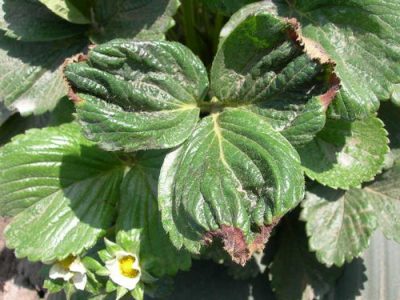
Calcium deficiency in plants. Source
Calcium is required by all plants to thrive and grow, it forms compounds which strengthen cell walls, calcium must be present for the formation of new sales. It increases fruit set and the overall quality. Calcium is also essential for growth of nodules (shoots) and root tips. Even though calcium is classed as a micronutrient by some, a plants need for calcium can be as high as it’s need for nitrogen and potassium.
Calcium has limited mobility and plants which basically means that plants can’t move calcium from old-growth to new growth, therefore new growth may begin to show signs of deformity, they may even wither and die back.
Calcium deficiency within plants has various effects such as causing roots to turn black and rot, the inhibition of bud growth, the premature shedding of fruit and buds, blossom end rot in many fruits, the deformation of young leaves.
Magnesium (Mg)

Magnesium deficiency in plants. Source
Without magnesium there would be no chlorophyll (it’s the only mineral component of chlorophyll) and without chlorophyll a plant would be unable to photosynthesise. Chlorophyll is also what gives plants their green colour. It is necessary for the translocation of phosphorus within a plant and also helps a plant to form and transport sugar and starches.
Magnesium deficiency will lead to a reduction in plant growth and yellowish, bronze or reddish colour of older leaves whilst the veins remain green. It will also affect a plants uptake of calcium, in an advanced stage of magnesium deficiency young leaves may grow spotted.
Magnesium can also leach from a plant in Sandy soil’s
Sulphur (S)
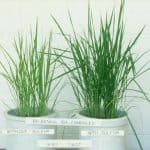
Sulphur deficiency in plants. Source
A plants requirement for Sulphur are similar to that of phosphorus, you will be glad to hear that sulphur deficiency is extremely uncommon. Sulphur is needed as it helps seed formation, oil content, develop vitamins, chlorophyll formation and nitrogen stabilisation.
Sulphur also contributes to develop flavours in some vegetables in particular onions, garlic and legumes.
Micronutrients
Boron (B)
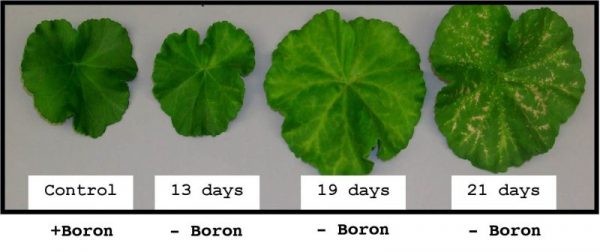
Boron deficiency in plants. Source
Boron contributes to the formation and stability of cell walls with calcium; it is an essential component for cell division (creating new plants cells); it is vital in the healing process of plants that have been damaged by either chewing insects or poor weather such as hail.
Baron is easily leached in sandy soils and will require regular top ups in very small quantities.
Baron is also critical to the growth of pollen tubes, cell division and elongation, the transportation of starches and sugars and hormone regulation.
Baron is very immobile in plants.
Boron deficiency will cause problems including the failure to set seed, the internal breakdown of fruit or vegetables, failure for the root tips to elongate normally, thick, curled, brittle leaves. Reduced pollen tube growth and flowering.
Baron deficiency tends to occur when the pH level of soil goes over 6.5 this is because Baron is tied up and unavailable for plant uptake.
Chlorine (Cl)
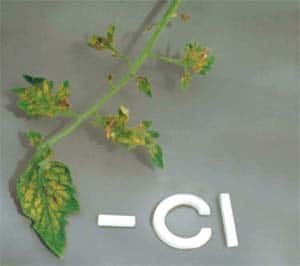
Chloride deficiency in plants. Source
Chlorine is only need in small quantities and chlorine deficiency is rare as it is widely available in nature. Chlorine is used in photosynthesis for gas exchange. It helps to regulate the stomatal opening in leaves, thus controlling the internal water balance. Chlorine also increases a plants protection against fungal infections.
Chlorine deficiency causes wilting and chlorosis (yellowing), excessive branching of lateral roots (club roots)
Copper (Cu)
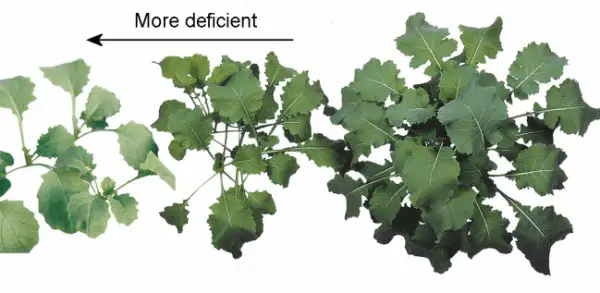
Copper deficiency in plants. Source
Copper is only needed by plants in trace amounts; however, plants can’t live without it. Copper is important for several reasons; it activates several enzymes in plants particular those which are involved in lignin synthesis. Helps to regulate water, it is needed in the formation of lignin and plays a part in the whole photosynthesis process.
Copper is immobile in plants.
Copper deficiency leads to misshapen leaves, wilted plants, stunted growth as the stem length between the leaves shortens, the colour of flowers is often lighter than normal.
Excess potassium, phosphorus or other micronutrients can indirectly cause copper deficiency, also if the soil has a high pH level this can cause copper deficiency due to less copper being available for plant uptake.
Please note that excess copper can restrict root growth by damaging the root tips leading to lateral root growth, not only that high levels of copper can compete with the plant’s uptake of iron and sometimes molybdenum chow or zinc.
Iron (Fe)

Iron deficiency in plants, leaf on the left is healthy . Source
This is another vital element; however, it’s only needed in small quantities, it promotes the manufacture of chlorophyll (the stuff that makes plants green this) in plant cells, it also assists in helps other vital functions such as symbiotic nitrogen fixation and the activation of biochemical processes such as respiration and photosynthesis.
Iron deficiency is extremely rare but it can happen when you have soil with a pH greater than 7.0.
The signs of Iron deficiency include twig dieback and interveinal leaf chlorosis. Leaf chlorosis is easy to spot this is when the leaves of the plant turn yellow but the veins remain green, this will start to show up on new growth first.
Manganese (Fe)
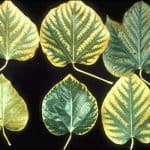
Manganese deficiency in plants. Source
Manganese is completely different to magnesium so don’t get these two confused.
Manganese is responsible for activating over 35 vital enzymes in the plant growth process, it is in chlorophyll synthesis and iron formation. Manganese also plays a part in regulating a plants carbohydrate metabolism.
Manganese deficiency is very rare, but it can happen.
The signs of manganese deficiency is again interveinal leaf chlorosis, however unlike the leaf chlorosis caused by iron deficiency there isn’t a sharp distinction between the yellowing of the leaf and the bright green veins.
Molybdenum (Mo)

Molybdenum deficiency in plants. Source
Even though this is just a trace element it has a vital role, it helps plants to use nitrogen, it helps in converting nitrates to ammonium which is an initial stage of protein synthesis. It is also essential in the fixation of atmospheric nitrogen by rhizobia, a good bacterium that is found within root nodules.
Some plants especially legumes, squash, gourds and melons are sensitive to molybdenum deficiency.
Molybdenum deficiency usually occurs in acidic, sandy soils, adjusting the pH to 6 usually corrects the problem.
The signs of molybdenum deficiency are similar to that of nitrogen deficiency because there is so closely related. You will see interveinal chlorosis with the smallest leaves remaining green, poor room size and colour, stunting, marginal scorching and coupling rolling of leaves.
Zinc (Zn)
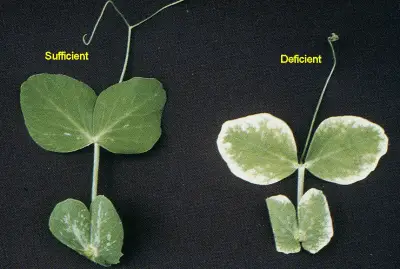
Zinc deficiency in plants. Source
This is another important micronutrient, if you’re planning growing large crops you will not achieve high yields without it.
zinc is the fundamental key in the germination of seeds and root development and is also required for the development of hormones and enzymes. Along with other nutrients zinc also helps form chlorophyll and carbohydrate, whilst also affecting water uptake and seed and stalk maturity.
Plants such as cereals oil, seeds, fruit and vegetables are prone to zinc deficiency. Zinc deficient crops will show signs of damage early in the season due to frost and cold conditions.
Signs of zinc deficiency will usually show on the leaves such as misshapen leaves, interveinal chlorosis usually start at the base of the leaf near the stem, chlorosis due to zinc deficiency usually starts on the lower leaves first and gradually moves up the rest of the plant. Premature leaf fall, stunted growth, the reduced size of seeds and fruit.
Nickel (Ni)
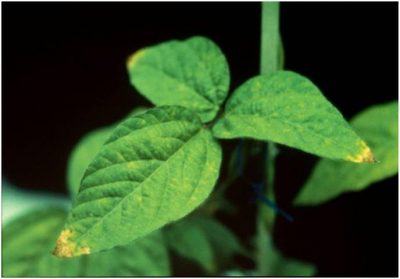
Nickel deficiency in plants.
Nickel is needed by plants in minute amounts; however, it is an essential element for plant growth. The good news is that nickel deficiency is extremely rare, however it can happen.
Nickel is needed by some plant enzymes, most importantly urease, it metabolises urea nitrogen into usable ammonia. Without nickel toxic levels of urea will accumulate within plant tissue causing necrotic lesions on leaf tips. Therefore, nickel deficiency causes urea toxicity in plants.
Within the legumes nickel is used by enzymes to help fix nitrogen, studies also suggest that nickel helps build disease tolerance in plants.
Minor nickel deficiency will show no signs, however major nickel deficiency will show as reduced growth, interveinal leaf chlorosis along with necrotic leaf tips.
In pecans and some other plants with nickel deficiency, leaves will develop a condition called “mouse-ear” in which the leaves are small with rounded tips instead of long and pointed.
So, there you have it, all 17 essential plant elements that are required for plant growth explained, plants cannot grow without the above mentioned essential elements.
Lesser known beneficial elements for plants
However, this isn’t as clear cut as it seems, because plant matter consists of over 60 elements including titanium (Ti), uranium (U) and aluminium (Ai)
Aluminium (ai) has been found to help tea plants provide increased growth and increased antioxidant properties.
Titanium (Ti) a study published by the Australian Journal of crop science has shown that Titanium improves nutritional status of plants, stimulates enzymatic activity, accelerates the uptake of nutrients, increases photosynthesis, participates in the synthesis of proteins & chlorophyll, and in the control of plant diseases
Silicon (Si) has been found to assist plants against biotic (fungi and insects) and abiotic stress (temperature stress, drought, heavy metal toxicity etc.) according to a study on frontiers in Plant Science
There are more and more studies being done that are showing other beneficial elements which may play a role in plants which include:
Silver (Ag)
Chromium (Cr)
Tin (Sn)
Cerium (Ce)
Tungsten (W)
Vanadium (V)
Lithium (Li)
Cobalt (Co) – Increases growth, and seed pod yield in leguminous plants like peas.
Who would have thought that plants could be so complex, plants a like mini mega factories, for the raw materials you have all the nutrients, then the finished product you have a tomato, a pear, or even an oak tree.
These mega factories will experience problems when they don’t get supplied with all the raw materials they need; you can’t make a wooden table without a saw or wood can you?
So, the main question here is how do you keep plants supplied with all the essential elements that plants need?
Well the answer is Fertiliser.
